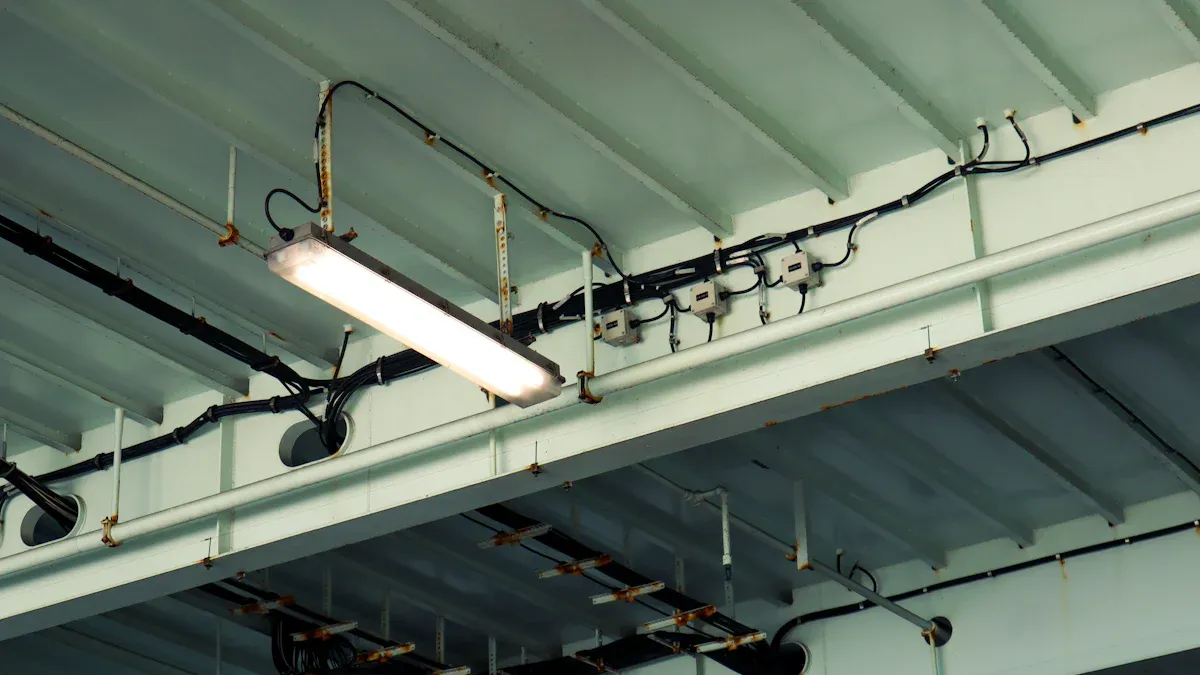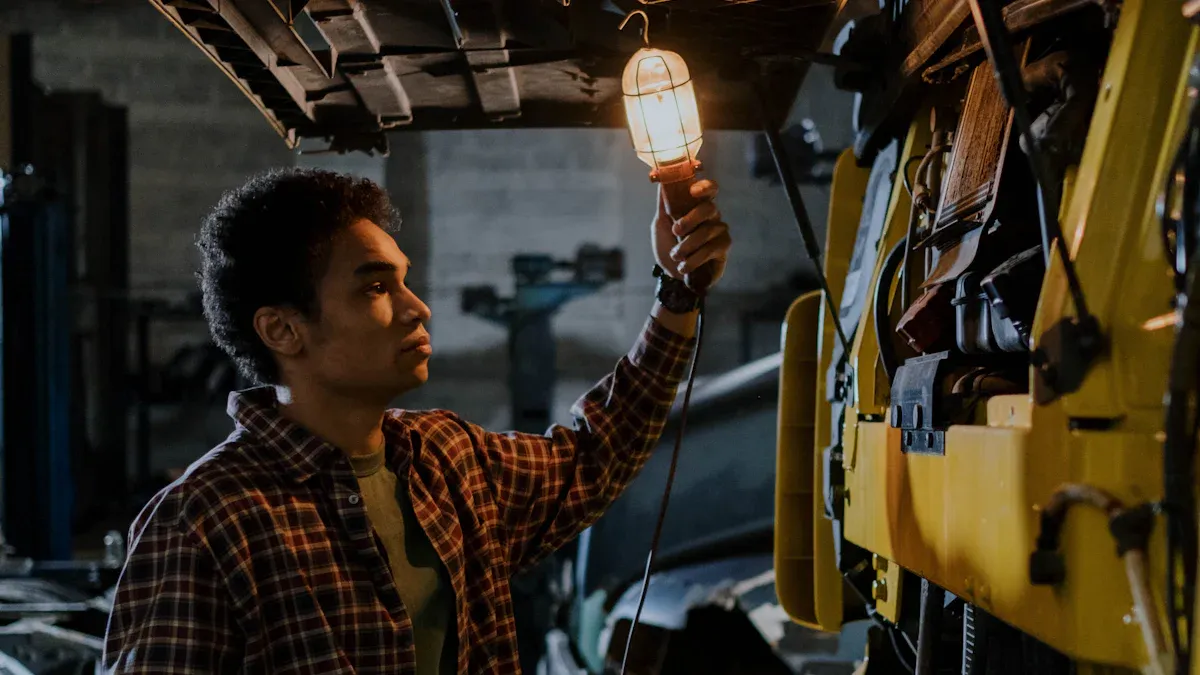LED High Bay Light Maintenance: Extending Lifespan and Troubleshooting Common Issues

You rely on your 150w led high bay light to deliver strong lighting in large spaces. Regular maintenance keeps your led high bay light working at top performance. Dust and debris can lower the output of high bay lights. Cleaning your lighting fixtures helps prevent this problem. High bay lights with proper care last longer and save money. At Home or in a Product warehouse, you want your Led Light to shine bright. About Us pages often share tips for getting the best results from lighting.
Key Takeaways
Wipe your LED high bay lights once a month with a soft, dry cloth. This helps them stay bright and safe.
Look at your lights every day for damage, loose parts, or dust. This helps you find problems early and stop bigger issues.
Check the electrical connections every month. Always turn off the power before you start. This keeps you safe and stops flickering or failure.
Watch for things like flickering, color changes, or overheating. Fix small problems fast or call a professional if you need help.
Pick good quality parts and follow the manufacturer’s instructions. This helps your lights last longer and saves you money.
LED High Bay Light Maintenance

Cleaning and Dust Removal
It is important to keep your lighting fixtures clean. Dust and dirt can cover your 150w led high bay light. This makes the light dimmer. Use a dry, soft cloth to wipe the fixtures. Do not use water or strong cleaners. These can hurt the lights. Check your high bay lights for dust every day. This is extra important in busy places like warehouses or gyms. Clean the fixtures at least once each month. This stops dust from building up. Cleaning helps your lighting last longer. It also keeps your space bright.
Tip: Cleaning often lowers safety risks. Dust can make lights overheat or even cause fires.
Visual Inspection
Looking at your lights is an important part of maintenance. Check your 150w led high bay light closely. Look for cracks or dents. See if there is any other damage. Make sure the fixtures are tight and not loose. Check the lens for cloudy spots or color changes. These can make the light worse. Every day, take a quick look at all high bay lights. This helps you find problems early. If you see damage, fix it right away. This stops bigger problems later.
Electrical Checks
You need to check the electrical parts to stay safe. Always turn off the power first. Look for loose wires or worn spots. Use a contact cleaner to get dust off the connectors. Make sure the 150w led high bay light is put in the right way. Check that the seals are tight. Bad installation can make the lights flicker or stop working. Do electrical checks every month. This keeps your lighting safe and working well.
Safety Reminder: Always follow safety rules when working with electrical fixtures. This helps you avoid getting hurt.
Environmental Factors
Things around your led high bay light can change how long it lasts. High heat, humidity, and dust can make your lighting wear out faster. Keep your fixtures away from heat and wet places. Use covers or shields if your space is dusty. Watch the temperature and humidity in your building. Good airflow helps your high bay lights last longer. Check the area around your fixtures every day. By controlling these things, you protect your lighting and make your space safer.
Environmental Factor | Impact on Lighting | Maintenance Tip |
|---|---|---|
Temperature | Reduces lifespan | Ensure good ventilation |
Humidity | Causes corrosion | Use moisture barriers |
Dust | Blocks light | Clean fixtures often |
Troubleshooting Common Issues

LED high bay lights can develop problems over time. You need to know how to spot and fix these common issues. Good troubleshooting helps you keep your lighting bright and safe. Here are some troubleshooting tips for the most frequent problems.
Flickering or Dimming
Flickering lights or dimming can make your workspace unsafe and uncomfortable. You might notice the lights blink or lose brightness. This problem often comes from loose wiring, faulty drivers, or power supply issues.
Troubleshooting steps:
Turn off the power to the fixtures before you start.
Check all wiring connections. Loose wires can cause flickering lights.
Inspect the drivers. Replace any drivers that look damaged or worn.
Test the power supply. Swap it with a working one if you suspect a problem.
If the problem continues, try isolating the fixture to see if only one light is affected.
Note: Always follow safety rules when working with electrical parts. If you feel unsure, call a professional.
Complete Failure
Sometimes, you may face lights not turning on at all. This is called complete light failure. It can happen because of bad wiring, broken drivers, or damaged LED chips. Persistent system failures can also point to bigger electrical problems.
Diagnostics for complete failure:
Make sure the power switch is on and the circuit breaker has not tripped.
Check the wiring for burns or breaks.
Test the drivers by replacing them with new ones.
Inspect the LED chips for dark spots or signs of burning.
If you see persistent system failures, you may need to check the whole lighting system.
Tip: If you cannot find the cause, call an expert for repairs. This keeps you safe and protects your fixtures.
Color Shifts
You may notice your lighting changes color over time. Sometimes, the light turns yellow, blue, or even pink. This uneven light distribution can make your space look strange and affect work quality.
Troubleshooting color shifts:
Check the lens for dirt or damage. Clean or replace it if needed.
Inspect the drivers. Old or faulty drivers can cause color changes.
Make sure the fixtures are not overheating, as heat can damage LED chips.
If you see color shifts in many lights, check for voltage problems in your building.
Alert: Color shifts can signal deeper issues with your lighting system. Fix them early to avoid bigger problems.
Overheating
Overheating fixtures can shorten the life of your lights and create safety risks. You may feel the fixture is hot to the touch or see the light dim after running for a while.
How to troubleshoot overheating:
Check for dust buildup on the fixture. Clean it to help heat escape.
Make sure there is enough airflow around the lighting.
Inspect the drivers. Overheating can mean the drivers are failing.
Look for signs of damage or melting on the fixture.
If overheating continues, you may need to move the fixture or add cooling.
Safety Reminder: Never ignore overheating. It can lead to fires or complete failure of your lighting.
A good troubleshooting process helps you find and fix problems fast. You protect your lighting investment and keep your workspace safe. Use these diagnostics to solve issues before they become serious. If you face persistent system failures, always put safety first and call a professional when needed.
Repair vs. Replace
When to Replace
You may wonder if you should fix your LED high bay light or get a new one. Sometimes, repairs make sense. Other times, replacement is the better choice. Look for these signs to help you decide:
The light does not turn on after you check the wiring and drivers.
You see burn marks or melted parts on the fixture.
The light keeps flickering or dimming, even after you try repairs.
The color of the light changes and does not return to normal.
The fixture gets very hot and cleaning does not help.
If you notice these problems, replacement is often safer and more cost-effective. Old or damaged lights can waste energy and create safety risks. New fixtures give you better performance and save money over time.
Tip: Always check your warranty before you buy a new light. Some manufacturers offer free replacements for certain issues.
Cost-Benefit Analysis
You want to make smart choices for your lighting budget. Use a simple cost-benefit analysis to help you decide between repairs and replacement. Compare the price of fixing the light to the cost of a new fixture. Think about the time and effort needed for each option.
Option | Upfront Cost | Long-Term Savings | Safety | Performance |
|---|---|---|---|---|
Repair | Lower | May be less | Varies | May decline |
Replace | Higher | Often greater | Better | Improved |
If repairs cost more than half the price of a new light, replacement is usually the best choice. New LED high bay lights use less energy and last longer. This saves you money in the long run. Always consider safety and performance, not just the price.
Remember: A quick fix may seem cheaper, but a new fixture can give you peace of mind and better lighting for years.
Maximizing Lifespan
Quality Components
You want your LED high bay lights to last as long as possible. Choosing quality components is the first step to a longer lifespan. High-quality LED chips, drivers, and heat sinks help your lights work better and last longer. Cheap parts often fail early and can lower the lifespan of your fixtures.
When you buy new lights, look for trusted brands. Check for certifications like UL or DLC. These marks show that the product meets safety and quality standards. You can also ask your supplier about the parts inside the fixture.
Tip: Quality parts may cost more at first, but they save you money over time. You will spend less on repairs and replacements.
Here are some things to check when picking quality components:
LED chips from well-known makers
Strong, well-built heat sinks
Reliable drivers with good warranties
A good choice now means fewer problems later. You protect your investment and keep your lights shining bright.
Manufacturer Guidelines
You should always follow the manufacturer’s guidelines to get the best lifespan from your LED high bay lights. These instructions tell you how to install, use, and care for your fixtures. If you skip these steps, you may shorten the lifespan of your lights.
Read the manual before you start. Follow the steps for mounting and wiring. Use the right voltage and avoid overloading the circuit. Clean and inspect your lights as the manufacturer suggests.
Note: Some companies require you to follow their rules to keep your warranty valid.
You can find extra tips in the manual for your specific model. These tips help you keep the best performance and avoid common mistakes. When you follow the guidelines, you make sure your lights last as long as possible.
You can keep your led high bay light working well by following regular maintenance steps. Clean your fixtures, check for damage, and fix problems early. Use quality parts and follow the manufacturer’s advice. Quick repairs and good care help your lights last longer and save money. Remember, best practices keep your space bright and safe.
Tip: Make a simple checklist to track your maintenance tasks each month.
FAQ
How often should you clean your LED high bay lights?
You should clean your LED high bay lights at least once a month. In dusty or busy areas, check and wipe them more often. Regular cleaning keeps your lights bright and helps them last longer.
What should you do if your LED high bay light keeps flickering?
First, turn off the power. Check all wiring connections for looseness. Inspect the driver for damage. If you cannot find the problem, call a professional. Flickering often means a wiring or driver issue.
Can you replace just the LED chip if it fails?
You can replace the LED chip in some fixtures. Check your product manual first. Some lights need a full fixture replacement. Always use the correct part for your model.
How do you know when it is time to replace your LED high bay light?
Sign | What It Means |
|---|---|
Light will not turn on | Likely needs replacing |
Color changes | LED chip may be failing |
Fixture overheats | Replacement is safer |
If you see these signs, consider a new light.
Do LED high bay lights work in cold or hot environments?
LED high bay lights work well in most temperatures. Extreme heat or cold can lower their lifespan. Use fixtures rated for your environment. Good airflow and proper installation help your lights last longer.

